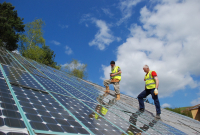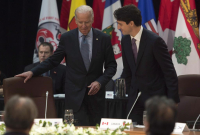Sorry, Canada. The world doesn’t need Keystone XL

Canada, can we talk? You just saw what happens when the leaders of governments tell tall tales about important issues, right? It turns out very badly, and we in Canada are left tsk-tsking about “how could the leader of a democracy mislead the public like that?” Well, here we go on our Canada-sized issues and tall tales. Once again in Canada ... governments, the fossil fuel industry and the media are in a tizzy about U.S. pipeline approvals with no regard to economics or logic.
The truth is we don’t need Keystone XL. Based on the Canadian Association of Petroleum Producers’ own forecasts, oilsands production increases are more than covered with planned increases to the Enbridge system (800 thousand barrels per day or 800 KBD), the current Keystone pipeline’s expansion (130 KBD), possible Enbridge Southern Lights reversal (150 KBD), and some miscellaneous projects. Then we have the white elephant of Trans Mountain our prime minister has saddled us with. That’s more than enough to get us through this decade and likely forever as the world has to start decarbonizing.
After all, in a sure sign global change is coming, even Ontario Premier Doug Ford is getting all excited about manufacturing electric vans in Ingersoll and electric cars in Oakville, the same guy who yanked out electric chargers at GO stations when he first got into the job. Every one of those EVs reduces the amount of oil we will burn in the future.
Fighting climate change means burning less fossil fuels. Burning less fossil fuels means less need for the difficult-to-process, high-carbon bitumen Alberta produces. In terms of economics, we’re the last barrels on the stack of global supply, and the first barrel people won’t want when demand goes down, as it must.
There was no upside for U.S. President Joe Biden to approve a line Canada says is needed, but isn’t. The only reason Donald Trump approved it was as an ill-concealed attempt to undo Barack Obama’s legacy. Here’s why none of the arguments work.
1. The U.S. needs this line for energy security.
No, they don’t. They’ll have access to the bitumen anyway with or without the line. Building the line won’t spur more development in the oilsands because smart money is more interested in short-payback fracked wells, much less risky in a decarbonizing world, not to mention much better quality crude. So without Keystone XL, the same amount of bitumen will be produced and the U.S. will still get all of it through the other pipeline projects. Even the bitumen flowing through the Justin Trudeau pipeline will most likely end up on the U.S. west coast.
2. We need the pipeline, so the U.S. should be good friends and approve it.
The argument might actually be worth putting forward if we actually needed the pipeline. The Americans know we don’t and it is all political theatre. Canadian politicians seem to need to pretend crude pipelines are the only things standing in the way of capital flowing back to the oilsands. They aren’t. The poor-quality, high-capital oilsands product is not preferred over the quick-payback, close-to-market fracked American oil. Smart money goes to fracking.
3. We’re working at reducing our carbon footprint so it isn’t that bad.
Yes, Alberta is getting off of coal for the electricity that powers the oilsands and experimenting with solvents to help lower the energy in extraction. But much of the oilsands' carbon footprint will still come from the natural gas burned to make steam to melt the bitumen in the ground so it will separate from the sand and flow, and that conversion from coal for electricity is also going to burn a lot of natural gas. Not to mention the big processing units that burn coke from oilsands refining when making synthetic crude, or the energy used to make hydrogen for that synthetic crude, and so on. Also, bitumen yields a large amount of petroleum coke when processed, whereas fracked oil makes almost none of that.
It’s hard to argue bitumen is a low-carbon source of supply when large amounts of carbon are needed to produce it and significant amounts of something that looks like coal is produced when it’s processed. So, while the new processes make oilsands carbon somewhat better than unbelievably terrible, there is no way for it to be good.
Yet Trudeau and Alberta Premier Jason Kenney still pretend pipelines are the saviour of the oilsands. Nobody outside of Canada believes that, they all know the truth — big money is not coming back to the oilsands, pipelines or no pipelines.
Right now as a country, we are upset as we see Pfizer vaccine doses reallocated to Europe instead of to us, and we get all worked up about the U.S. cancelling an unneeded pipeline. We should be asking ourselves how we set priorities. Why as a country did we decide high-carbon, remote, difficult-to-produce uneconomic bitumen was a strategic product and allow our own vaccine manufacturing capability to slip away unnoticed?
Good leaders should protect us from real threats like pandemic viruses and stop fighting the inevitable wind down of our fossil fuel industry. It just takes courage on their part to tell the truth and our part to listen.
Ross Belot is a retired senior manager with one of Canada’s largest energy companies. He is now an environmental poet.






Comments
Exactly. Thank you for a factual explanation. It means a great deal coming from someone who has worked for both the energy sector and the environment.
Belot: "The poor-quality, high-capital oilsands product is not preferred over the quick-payback, close-to-market fracked American oil. Smart money goes to fracking."
1) With the greatest concentration of heavy-oil refineries in the world, the U.S. Gulf Coast oil complex sources heavy oil primarily from Mexico, Venezuela (until recently), Colombia, and Alberta. In recent years, meanwhile, the U.S. has been boosting exports of its own fracked light oil to Asia.
California's complex high-conversion heavy oil refineries prefer heavy oil, especially at a discount. Indeed, California seems to be the primary destination for AB dilbit exported via the Trans Mountain Pipeline.
2) Capital has been fleeing U.S. shale oil as well:
"'Oil sector cutting spending as Wall Street turns its back' (July 2, 2019)
"Rising production. Weakening demand. Skeptical investors.
"… Crude has struggled to break out of the $50-to-$60-a-barrel range. … Some companies can still make money at those levels, but not enough to fuel significant expansions or satisfy increasingly impatient investors. Wall Street already has turned its back on the sector, unhappy with its lackluster returns but also increasingly focused on challenges to the industry— and earnings — from climate change, renewable energy and EVs.
"The S&P Energy index is down more than 16% in the past 12 months even as the broaders S&P 500 index has gained 9%.
"After the recent oil crash that ended in 2016, the door for funding oil & gas companies was wide open as banks and investors became eager to finance the land rush in West Texas’ booming Permian Basin and get in on the rebound. But the land rush proved costly, and many companies, loaded with debt, have yet to turn a meaningful profit.
"'We’ve done pretty much a 180-degree turn,' said Brian Lidsky, senior director at the Austin-based research firm Drillinginfo. 'That door started to shut in 2018 and now the lock has been put on.'
"… As funding tightens, many companies will need to rein in spending, slow projects and trim payrolls.
"Since oil prices plunged late last year, industry sentiments have turned dour and spending was down in the second quarter of 2019 after 3 years of growth, according to new survey data from energy executives collected by the Federal Reserve Bank of Dallas.
"'Results indicate a further slowdown in the oil & gas sector, with increasing pessimism and a surge of uncertainty,' said Michael Plante, the Dallas Fed’s senior research economist.
"Arguably the most ominous sign for the oil sector is growing U.S. oil output — even as dollars and drilling activity decline — against weakening global demand and rising concerns of a global economic slowdown. … But more oil hasn’t necessarily translated into more profits.
"…But companies looking to spend to grow quickly are getting punished by Wall Street.
"With too many small players and shrinking access to capital, both the production and oilfield services sectors face consolidation.
"https://www.houstonchronicle.com/business/energy/article/Oil-sector-cut…
That trend was identified pre-COVID. The pandemic only amplified shale oil's capital crisis:
"Investment in U.S. Shale Projects to Halve in 2020, IEA Says" (May 27, 2020)
"Investment in the U.S. shale sector will drop by half this year, the International Energy Agency said Wednesday, predicting a period of pain for producers, even as oil prices rally.
"The forecast body blow to the availability of capital for U.S. producers comes as part of an expected world-wide decline in broader energy investment during 2020. The Paris-based organization expects global investment in oil and gas to decrease by one-third and the financing of all energy projects to decline by 20%.
"'We see a historic fall in global energy investment, but the biggest hit is to the shale industry,' said the agency’s executive director, Fatih Birol. 'It has always been under pressure, but now access to capital and investment confidence is drying up.'
"With oil prices long-trading below the cost of production for shale producers, several companies have been forced to file for bankruptcy in recent months, while U.S. major oil companies have slashed capital spending.
"The drop in spending has already reduced U.S. output as shale companies drill less and shut in existing wells.
"Other organizations also forecast a seismic hit to U.S. shale investment this year. Rystad Energy projects a 54% hit to the sector’s available capital. 'We do not anticipate upward revisions in capital guidance despite improvement in market fundamentals,' said Artem Abramov, Rystad’s head of shale research."
https://www.wsj.com/articles/investment-in-u-s-shale-projects-to-halve-…
Correction: California seems to be the primary destination for AB dilbit exported via the Trans Mountain Pipeline EXPANSION (TMX).
You are absolutely correct to point out the first hidden fact about fracking: the companies are saturated in debt. The second hidden fact, even further down the hole, is the severe decline rates of hard rock drilling and fracking, usually averaging a tad above 50% less production after just the first year, sometimes over 90% depending on the localized geological characteristics of shale formations. There is a good reason why the fracked plains landscape of the Dakotas looks like a pincushion from the air.
These issues have been extensively analyzed by geoscientists like David Hughes and Art Berman. Hughes, with over 30 years experience with Natural Resources Canada, warned BC about puffing up the arguments supporting LNG only to be countered by the oncoming high decline rates of the Montney and Horn River formations, not to mention the methane release.
"This is madness. He's just peddling a bunch of easy answers."
-- Lisa Simpson, Season 5, Episode 7 (~ 1997)
I keep waiting for the other shoe to drop, but I suspect for some too deep in the weeds and possibly still dismayed that martial law wasn't declared south of the border last week, it may never happen. As they say, "a lesson is repeated until learned".
For the rest of Albertans, it's time to leave those dinosaurs in your dust and focus your can-do spirit on the economy of 2030 and beyond.
"Every one of those EVs reduces the amount of oil we will burn in the future."
Good article, but I've never seen the numbers to back up the statement above. Numbers that include cradle to grave mining, manufacturing, and disposal.
You don't need the actual numbers to figure that out. Just consider that cars are cars: they need to be built. Cars already use batteries.
EVs don't use fossil fuel. "Regular" cars do.
So every EV that displaces a gasoline-fueled car (or, for that matter, natural gas fueled car) will result in burning of less oil.
If my logic seems flawed, please point out where.
Excellent article. Kudos!